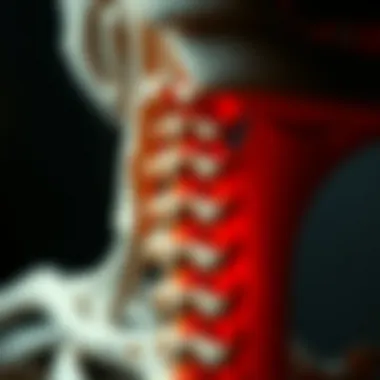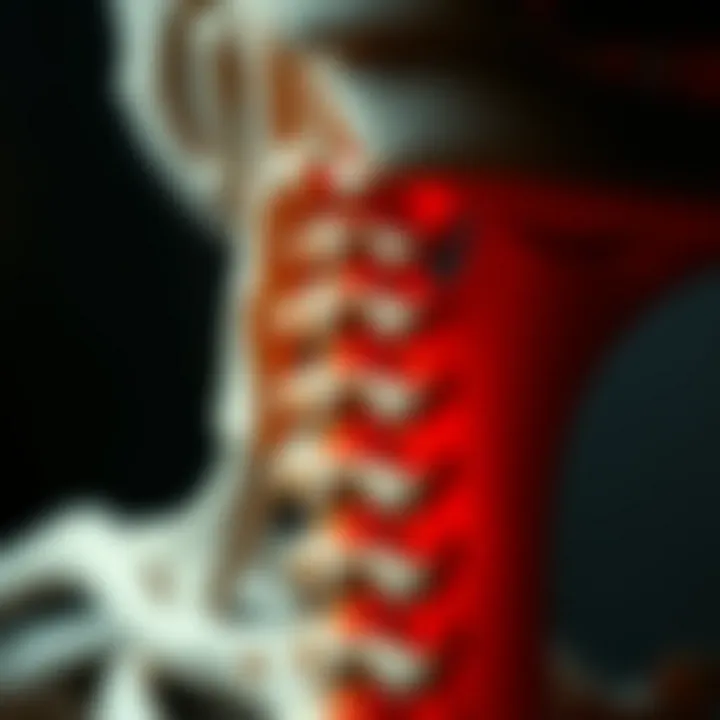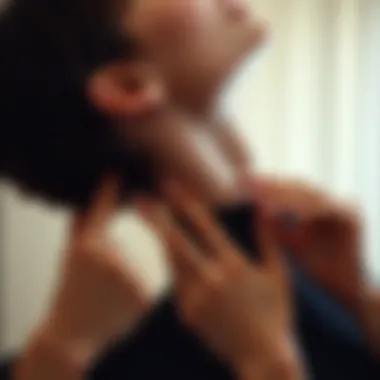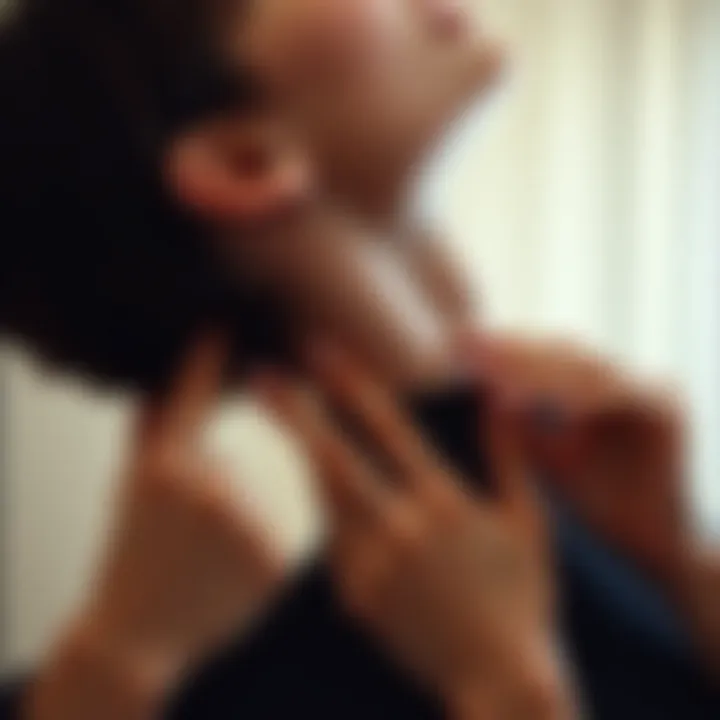Exploring the Neck Popper Phenomenon: Insights and Risks


Intro
In today’s wellness landscape, few practices spark as much debate as the neck popper phenomenon. Many folks may have heard the crack and pop noises that accompany the adjustment of one's neck, either performed by a professional chiropractor or even by the individual themselves. While it might seem simply like a party trick or a method to relieve tension, the intricacies of this practice go deeper than they may appear.
Understanding what drives the popularity of this habit requires looking at different angles; the mechanics behind it, its perceived benefits, potential risks, and cultural adaptations worldwide. All of this works together to paint a much richer picture of why neck popping is so prevalent in various circles. From the casual office worker to health enthusiasts, there’s widespread curiosity about whether this intriguing practice was rooted more in anatomy or psychology
That being said, this article aims to provide a thorough exploration of the neck popper phenomenon through various lenses. Readers will gain insights not only into the mechanics involved—how the cervical spine yields to such manipulations—but also the wider cultural context that shapes perceptions and practices surrounding it.
Whether you are a medical professional, a student of health sciences, or simply curious, the upcoming sections will furnish you with a balanced take on the neck popper experience.
So roll up your sleeves and get ready as we navigate through the complexities of the neck racket to uncover the truths, implications, and practices surrounding it.
The Anatomy of the Neck
The neck is a complex structure that plays a crucial role in our daily lives, serving as the bridge between the head and the body. Comprised of bones, muscles, ligaments, and joints, understanding the anatomy of the neck is essential for grasping the neck popper phenomenon. This phenomenon, often viewed as a simple act of cracking or popping the neck, actually involves a delicate interplay of elements that can yield both benefits and risks.
Knowing how the cervical spine functions can shed light on why many people engage in this practice. When we understand the anatomy of the neck, we can begin to appreciate not only the mechanics but also the implications for overall health and well-being. The intricate interactions between these structures provide context that informs both casual and informed discussions about neck manipulation.
Understanding Cervical Structure
The cervical spine, or neck region, consists of seven vertebrae labeled C1 to C7. These vertebrae are uniquely shaped to allow for a wide range of motion while maintaining stability. The C1 vertebra, also known as the atlas, supports the skull and is crucial for nodding the head. In contrast, the C2 vertebra, or axis, acts as a pivot, allowing for rotational movement. Each vertebra is separated by intervertebral discs that serve both as shock absorbers and connecting segments.
The overall structure of the cervical spine is not just about bones; it also encompasses the spinal cord, a vital pathway for nerve signals. Certain nerves exit through the cervical region, innervating the arms and upper parts of the body. A keen understanding of this anatomical structure helps to contextualize the actions associated with neck popping.
Muscle Groups Involved
Muscles play a significant supporting role in neck function and are essential when discussing neck popping. The neck is home to various muscle groups that work together to allow movement and stability:
- Sternocleidomastoid: This prominent muscle runs from the sternum to behind the ear and is significant for head rotation.
- Trapezius: A large muscle running from the base of the skull to the middle of the back, it aids in moving your shoulder blades and stabilizing the neck.
- Splenius: Located at the back of the neck, the splenius muscles assist in head extension and lateral rotation.
When people pop their necks, it is usually these muscle groups that are stretched or adjusted, affecting how the vertebrae align and function. Recognizing these muscle interactions offers insights into the practice's mechanics and why many experience temporary relief during or after a neck pop.
The Role of Joints
The neck joints, particularly the facet joints, play a critical role in facilitating movement. These joints allow the vertebrae to articulate, supporting the wide range of motions such as bending, twisting, and tilting the head. Each joint contains synovial fluid which lubricates the surfaces, reducing friction and preventing wear and tear during movement.
Moreover, the alanto-occipital joint, located between the skull and the first cervical vertebra, is responsible for nodding. Each of these joints has a unique structure that allows for specific movements but also makes them susceptible to stress and injury. Many individuals find relief in popping their necks, impacting these joints by creating a quick change in pressure, often felt as a release.
Understanding the anatomy of the neck is not merely an academic exercise; it holds practical significance for anyone looking to pursue neck manipulation safely and effectively.
Gaining a comprehensive understanding of the anatomy of the neck lays the groundwork for analyzing the neck popper phenomenon. Each element discussed provides insight into how the neck operates and the potential implications of practices like neck popping.
What is a Neck Popper?
Understanding what exactly a neck popper is plays a vital role in grasping the broader conversations this article embarks upon. This practice, while often dismissed as just another fleeting trend, carries with it layers of significance woven through anatomy and culture. It may seem trivial to some, yet many individuals frequently engage in this behavior, finding comfort or release through it. Exploring how this phenomenon is squeezed between convenience and caution reflects deeper societal attitudes around health and well-being.
Definitions and Variants
The neck popper, often referred to as self-manipulation of the cervical spine, involves a deliberate action that creates an audible ‘pop’ or crack. This sound, resulting from the release of gas bubbles in the synovial fluid surrounding the joints, tends to form an instant association with relief – almost akin to popping your knuckles. However, it’s crucial to note that this practice comes in various forms.
- Self-initiated Pop: Many folks try this on their own by tilting or turning their necks in certain ways that they believe aid in releasing tension.
- Partner-Assisted: Some enlist the help of another person to achieve the desired sound, typically done using a series of gentle twists.
- Chiropractic Practices: Here, trained professionals use refined techniques to manipulate the cervical area safely, providing a more controlled environment.
Understanding these definitions and variants not only clarifies the topic but also sets the stage for secondary questions regarding efficacy and safety.
Common Techniques
Those who partake in neck popping often have their own preferred methods, but many of these techniques can generally be grouped into a few broad categories. For instance, a common approach involves gently turning the head to one side and slightly tilting it back, allowing the joints at the base of the skull to release.


- Side Tilts: Dropping the ear toward the shoulder while maintaining a relaxed posture can sometimes yield the familiar popping sound.
- Rotary Movements: Slowly rotating the head in a circular fashion can help in loosening tight muscles, potentially leading to that sought-after sound.
- Static Pressure: Some people apply pressure using their hands on the head or neck for a set duration, hoping to coax joint movement.
The variety of techniques isn't just a matter of preference; it opens discussions surrounding effectiveness and the varying levels of risk each method may carry.
Frequency of Practice
How often does one engage in neck popping? This question lacks a simple answer as numbers vary widely among individuals. Some might do it unconsciously throughout the day, while others might indulge once in a blue moon. It's not rare for this practice to become a habitual response to stress or discomfort. However, frequent practitioners often report varying experiences.
- Casual Users: Those who pop their necks once or twice a week might do so primarily for an immediate sense of relief.
- Regular Practitioners: Individuals who find comfort in neck popping often practice it daily, sometimes multiple times a day.
- Faddists: A shift in fads has also seen a rise in those who mimic neck popping after watching videos or social media trends, whether for reassurance or curiosity.
Understanding the frequency of practice sheds light on the normalization of neck popping, expanding its acceptance into everyday routines. The conversation surrounding the neck popper phenomenon is multifaceted, and through definitions, techniques, and frequency, we begin piecing together a clearer narrative of its implications.
Perceived Benefits
The phenomenon of neck popping is more than just a momentary physical experience; it’s a practice that many engage in for various perceived benefits. Understanding these benefits is crucial, not just for those who partake in the practice but also for health professionals, stylists, designers, and marketers who seek to comprehend how this cultural aspect influences well-being and personal branding. In this section, we will delve into the immediate relief from tension, enhanced mobility, and psychological satisfaction associated with neck manipulation.
Immediate Relief from Tension
For many individuals, a neck pop serves as a quick fix for physical discomfort. People often report a noticeable decrease in tension immediately after manipulating their necks. This relief can be attributed to the release of built-up pressure in the cervical spine. With so many people facing stress daily, resulting in tight neck and shoulder muscles, the satisfaction of a good crack is hard to understate.
Research suggests that the sound produced during this action is due to the release of gases within the joint, which can give a sensation of release. It’s similar to a pressure valve being opened, letting out all the pent-up stress. However, while many might swear by this method, it’s essential to consider that such relief is often temporary and holds no substitute for professional care.
"A neck crack might be like putting a Band-Aid on a bullet wound; it feels great momentarily but doesn’t address the underlying issue."
Enhanced Mobility
Another significant benefit that enthusiasts often cite is enhanced mobility. After engaging in neck popping, many feel they can rotate or tilt their necks more freely. The manipulation can lead to increased range of motion, which may help improve daily activities or sports performance. Emerging adults in particular often turn to this practice to alleviate stiffness after long hours at desks or during periods of intense physical activity.
However, improved mobility doesn’t come without caveats. Some individuals may develop a reliance on self-manipulation, believing that popping one’s neck regularly is a necessity to maintain flexibility. This can lead to a cycle where your body becomes accustomed to external joint handling instead of natural movement.
Psychological Satisfaction
Finally, let’s discuss the psychological benefits. The act of neck popping can bring about a feeling of control over one's body and well-being. Many cherish this act not just for the physical advantages but for its comforting predictability. By popping their necks, individuals might find a moment of solace amid chaos.
The sound itself can act as a form of auditory gratification. For some, it’s a satisfying end to a stressful day or a personal ritual, much like others may find comfort in a cup of tea or a long walk. This psychological aspect cannot be overlooked, revealing how the mind and body are intricately connected in experiences of relief.
In summary, while the perceived benefits of neck popping range from immediate physical relief to enhanced mobility and even psychological satisfaction, these must be approached judiciously. Understanding these elements allows for a more rounded view of the neck pop phenomenon, paving the way for more informed discussions within cultural and health contexts.
Potential Risks and Dangers
Understanding the potential risks and dangers related to the "neck popper" practice is essential. This section sheds light on some of the issues surrounding this common activity, highlighting specific elements and the considerations that arise. Though many people might view neck popping as a harmless relief technique, there are serious aspects to consider that can have both short-term and long-term implications for one's health.
Short-Term Effects
The short-term effects of neck popping can vary across individuals. For some, the immediate satisfaction might be palpable. However, popping the neck can lead to unintended consequences:
- Muscle Strain: Performing neck manipulations improperly can create sudden strains in the muscles, leading to discomfort.
- Dizziness: Some individuals report feelings of lightheadedness after popping their necks. This could arise from a quick change in blood flow or nerve engagement.
- Pain: It's possible to experience acute pains immediately following the action due to misalignment or overextension of the cervical spine.
- Temporary Relief: While there might be a feeling of relief in the moment, this doesn’t always translate into long-lasting benefits. Relief can be short-lived and leave one feeling stiff shortly after.
Long-Term Consequences
The long-term consequences of habitual neck popping may paint a different picture entirely. Over time, consistent manipulation can lead to more significant health issues. Here are some potential risks to keep in mind:
- Joint Degeneration: Frequent neck popping can wear down the cartilage in cervical joints prematurelly, which may lead to arthritis.
- Chronic Pain: What starts as a momentary pleasure can evolve into persistent pain, sometimes in the form of chronic neck pain.
- Nerve Damage: Prolonged improper techniques can lead to nerve compression. This might cause sensations like tingling or numbness in the extremities.
- Vertebrae Misalignment: Continuous popping without professional guidance might result in misalignment that could require medical intervention to correct.
When to Seek Professional Help
In light of the potential risks associated with neck popping, it’s crucial to know when to reach out for professional help. Here are signs that suggest medical advice should be sought:
- Persistent Pain: If discomfort hangs around long after the act or intensifies instead of subsiding, it’s time to consult a physician.
- Neurological Symptoms: Experiencing tingling, numbness, or weakness in the arms or hands should not be ignored, as these could indicate serious underlying issues.
- Visual Disturbances: If neck popping is accompanied by sight issues, such as blurred vision or dizziness, medical intervention is necessary.
- Limitations in Movement: Should neck mobility decrease significantly, with stiffness or pain, a healthcare professional’s evaluation would be prudent.


It's important to listen to your body. When in doubt, it’s best to reach out to a healthcare professional for advice.
Cultural Perceptions
Understanding the cultural perceptions surrounding the neck popper phenomenon is crucial in grasping its significance and implications. This practice, while seemingly benign or even amusing to some, can elicit completely different reactions across various cultures. Not only does it reveal how body manipulation is viewed, but it also prompts reflections on health, wellness, and societal norms. The nuances in acceptance of neck popping can reflect deeper beliefs and values regarding the human body and its maintenance.
Global Perspectives
Around the globe, the neck popper is perceived through diverse lenses. In some cultures, it is welcomed as a form of self-care, deeply ingrained in the practice of physical health. For instance, in Japan, gentle neck stretching has long been a part of traditional practices aimed at promoting wellness and flexibility. Many individuals across Southeast Asia regard this manipulation favorably, associating it with relief from both physical tension and mental stress.
Conversely, there are cultures where such body manipulation ignites skepticism or concern. In certain parts of Europe and North America, people often regard the neck popper as potentially dangerous, linking it to severe spinal injuries or neurological issues. This difference in acceptance may stem from varying beliefs about anatomy and the risks associated with self-induced manipulations.
Cultural Attitudes toward Body Manipulation
Cultural attitudes toward body manipulation can portray significant divides—separating admiration from aversion. In traditions emphasizing holistic health, body manipulation techniques, including neck popping, are often embraced. These practices are viewed as tools for achieving balance and harmony within oneself.
On the other hand, skepticism sometimes arises because of medical advice warning against self-adjustment techniques without professional guidance. Without proper understanding, the neck popper might be dismissed or perceived as frivolous. This attitude can create a significant gap in knowledge and practice, where genuine self-care methods are left unexplored.
Popularity in Mainstream Media
The portrayal of the neck popper in mainstream media has a dual nature. Television shows, online videos, and documentaries often showcase the neck popper as a comedic trope or an exaggerated stunt. Yet, they also unintentionally contribute to the normalization or acceptance of body manipulation among the public. Influencers and wellness advocates on platforms like Instagram or TikTok frequently emphasize neck popping as a quick fix for discomfort, often without caution against its implications.
Moreover, interviews with health professionals discussing the neck popper often appear in wellness blogs, suggesting a burgeoning acceptance of this practice. However, this popularity raises concerns about misinformation or improper techniques being popularized, emphasizing the need to critically evaluate what is seen in media.
The way body manipulation is perceived varies widely; acceptance and understanding can change how individuals approach their own well-being.
The Psychosocial Aspects
The practice of neck popping is not solely a matter of physical manipulation; it intertwines deeply with the psychosocial fabric of human behavior. These aspects encompass how people's beliefs, interactions, and communal attitudes shape their engagement with this phenomenon. Understanding these elements sheds light on why individuals gravitate towards neck popping, as well as the varying perceptions and implications surrounding it.
Celebrity Influence
In an age of celebrity worship, figures in the limelight can significantly mold norms and practices, including neck popping. When a well-known actor or influencer casually shares their experiences with neck adjustments, it instantly lends an air of credibility to such actions. This phenomenon is often magnified on platforms like Instagram or Twitter, where short clips illustrate the practice, making it appear less intimidating and more appealing.
Many fans see these prominent figures as aspirational, leading them to mimic behaviors they observe. As a result, neck popping has a tendency to become a trend—consider the rapid spread of yoga or fitness routines spurred by social media personalities. Consequently, the idea that neck popping alleviates stress or tension can gain traction, reinforced by celebrity endorsements. Celebrities like Demi Lovato and Justin Bieber have openly discussed their experiences with chiropractors and the relief they felt, prompting fans to try it themselves, often without sufficient knowledge.
Social Media Trends
The digital landscape has birthed numerous trends, and neck popping is certainly no exception. On platforms such as TikTok and YouTube, clips demonstrating not just the act of neck popping but the exaggerated reactions immediately after it have garnered millions of views. These videos frequently present neck popping as an instant solution to stress, catching the eye of diverse audiences—from students looking for quick relief from study-related tension to professionals desiring a break from their desk work.
However, social media also presents a dual-edged sword. While it can spread awareness and educate (providing tips on best practices, for example), it may also propagate misinformation. Users may blindly adopt techniques seen in videos without understanding the potential risks. Watching a viral video can easily translate into a rush to replicate the actions without consideration of individual health concerns.
Group Dynamics and Peer Pressure
The social context around neck popping often resembles a game of follow-the-leader. If one person in a group demonstrates neck popping and exclaims about its relief, others might feel an implicit pressure to join in. This peer influence can create a cycle where practices are perpetuated, not necessarily for their efficacy, but rather out of a desire to fit in or share in the experience.
In various environments, from college dorms to workplaces, you might witness groups adopting neck popping as a collective stress-relief method. The act can transform from an individual practice into a group ritual, where peers validate each other's experiences, further embedding this behavior into the fabric of social interaction among friends. It is imperative to recognize, however, that this practice often overlooks personal health and well-being; what works for one individual might not work for another, but group dynamics can obscure these important differences.
"When the group aligns around a behavior, the individual considerations can often be overshadowed by the collective experience."
Alternative Practices
Alternative practices related to neck manipulation provide an essential lens through which we can explore the neck popper phenomenon more thoroughly. These practices often aim to promote overall wellness, relieve tension, and enhance physical and psychological well-being. Their significance lies not only in their holistic approach but also in their contrast to the often abrupt methods seen in neck popping. Here, we will discuss three important alternative practices: chiropractic adjustments, physical therapy techniques, and mindfulness and relaxation approaches.
Chiropractic Adjustments
Chiropractic adjustments are a popular alternative therapy designed to address musculoskeletal issues. These often involve techniques employed to realign the spine, including the cervical region. Unlike the self-administered neck popping, a trained chiropractor employs methods that target specific vertebrae and involve precise force application, promoting spinal health and function.


Benefits of chiropractic adjustments include:
- Pain Relief: Patients often report a significant decrease in neck and back pain following adjustments.
- Improved Mobility: Realigning the spine can lead to increased range of motion, helping individuals engage in daily activities more easily.
- Preventive Care: Regular visits can help maintain spinal alignment and prevent further issues.
It's vital, however, to consult licensed practitioners to ensure safe practices. A well-established chiropractic office typically employs a range of techniques, often tailored to the individual’s needs, making it a reliable alternative for those wary of neck popping but seeking relief.
Physical Therapy Techniques
Physical therapy focuses on rehabilitation and prevention of pain through individualized exercises and methods. Physical therapists assess the patient’s unique challenges and create customized plans that cater to specific issues, which may include neck stiffness or musculoskeletal pain.
Key techniques used in physical therapy for neck issues include:
- Manual Therapy: Techniques such as soft tissue mobilization can target muscles and joints directly, facilitating relaxation and improved function.
- Strengthening Exercises: Targeted exercises help to stabilize the neck and decrease the likelihood of injuries in the future.
- Posture Correction: Therapists can provide guidance on maintaining proper posture, reducing strain on the neck.
One of the great assets of physical therapy is the educational aspect, as therapists not only treat the symptoms but also empower patients with knowledge about their condition.
Mindfulness and Relaxation Approaches
Mindfulness and relaxation techniques focus on the connection between mind and body, which can play a pivotal role in easing neck tension. Stress is often a significant contributor to neck discomfort. Practices such as yoga, meditation, and deep-breathing exercises can improve awareness of bodily sensations and reduce stress, leading to a natural alleviation of tension.
Benefits of mindfulness include:
- Stress Reduction: Regular practice can help lower anxiety levels, contributing to physical relaxation in the neck area.
- Enhanced Self-Awareness: Individuals become more in tune with their bodies, allowing them to recognize early signs of tension.
- Increased Resilience: People can build a toolkit of coping mechanisms to manage stress in their daily lives, which can have direct benefits for physical health.
Incorporating these alternative practices may offer more sustainable solutions compared to neck popping, promoting overall well-being while considering individual needs.
The diversity in alternative practices allows individuals to choose approaches that resonate with them, potentially leading to a healthier lifestyle.
For further reading on chiropractic practices and techniques, you may visit Chiropractic Science or explore physical therapy information at PhysicalTherapists.org. Mindfulness techniques can be found in guides like those on Mindful.org.
Expert Opinions and Research
Gaining insight from experts in the field regarding the neck popper phenomenon is invaluable. The landscape of neck manipulation is not just filled with personal preferences or anecdotal evidence; it carries significant weight when viewed through the lens of medical expertise and scientific study. Understanding what medical professionals and researchers say can illuminate the nuanced layers of this practice, enhancing our overall comprehension.
Medical Community's Viewpoint
The medical community often approaches the neck popper with a cautious eye. Many health professionals acknowledge that while some individuals report immediate relief from tension and discomfort, the practice is not universally recommended. Some healthcare providers emphasize the importance of knowing the mechanical risks involved. For instance, maneuvers improperly executed may lead to injury. In particular, experts frequently advise against self-adjustments using force, noting that this can increase the risk of joint damage or vascular complications.
Moreover, physicians like Dr. Sara Brenner, who specializes in musculoskeletal disorders, state that professional guidance is essential when considering any cervical manipulation. They advocate for clinical assessments to identify underlying conditions that need attention before manipulating the neck. This viewpoint aligns with the broader consensus in the medical community about prioritizing safety and informed decision-making.
Scientific Studies and Findings
Research studies examining the biomechanics of the neck suggest a complex interplay between the cervical vertebrae and surrounding soft tissues. A pivotal study conducted by the Journal of Manipulative and Physiological Therapeutics highlighted that while spinal manipulation may improve mobility, it remains essential to understand the risks. The authors found that, though many participants experienced temporary relief, their effects varied significantly among individuals.
Additional research published in the European Spine Journal pointed out the potential risks such as vertebral artery dissection and cervical radiculopathy. These findings underscore the necessity for ongoing research to unravel the long-term effects of frequent neck popping. With notable cases documented in varied demographics, the narrative indicates a pressing need for further rigorous follows on this practice.
Personal Anecdotes from Practitioners
Personal experiences and testimonies from practitioners often provide a real-world view of the effects of neck popping. For instance, chiropractor Alex Thompson shares a recurring observation:
"Many clients come in believing that popping their neck is normal and even therapeutic. However, I always remind them that the sound does not always equate to any structural benefit. It can lead to a false sense of security."
Additionally, physical therapists like Maria Chen note interesting behavioral patterns:
"Some of my patients admit they feel a psychological urge to pop their necks, as if their bodies crave it. But they often overlook the importance of mindfulness about what goes on in their spines."
These anecdotes serve as a reminder of the subjective nature of our experiences and the need for a cautious and informed approach to exploring neck manipulations.
In summary, expert opinions and research contribute crucial dimensions to our understanding of the neck popper phenomenon. They highlight not just the potential benefits and risks but also the ethical considerations surrounding self-care practices. As we progress, it becomes increasingly important to balance personal experiences with professional guidance.
Culmination
Wrapping up our exploration of the neck popper phenomenon, it’s clear that this practice intertwines physical, psychological, and cultural threads. Not only does it provide immediate relief from tension, but it also comes with a myriad of implications that merit deeper reflection.
- Summary of Insights: We have seen that the mechanics behind neck popping are far more complex than one might initially think. It taps into intricate anatomical structures and involves various muscle groups and joint alignments. The perceived benefits often motivate individuals to indulge in neck manipulation, driving the popularity of this practice through social channels. Key takeaways from our discussion highlight the dual nature of neck popping: a potential source of satisfaction and relief contrasted by the risks associated with improper technique.
- Future Directions for Research: Looking ahead, there is much room for further inquiry into the effects of neck popping across different demographics and how cultural perceptions shape its practice. More rigorous studies could shed light on the long-term consequences of neck manipulation, ideally leading to informed guidelines that can help individuals navigate this practice safely. Exploring the psychosocial aspects, particularly the influence of peer dynamics and mass media, can also enrich our understanding of why neck popping remains so entrenched in contemporary routines.















